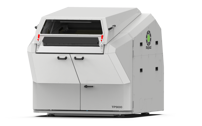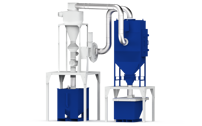FAQ
We’ve Got the Answers You’re Looking for
- /
- FAQ
Frequently Asked Questions
Rapid Granulator manufactures the equipment used for recycling plastic materials within the plastic producing sector. This involves converting unwanted or excess plastic products from manufacturing into reusable materials, focusing on industrial plastics rather than household waste.
Types of recyclable materials:
- Manufacturing waste: Offcuts and defective components from processes like thermoforming, which need to be clean and free of contaminants like metal.
- Post-industrial items: Non-returnable plastic containers or packaging used in industrial settings.
- Excess stock: Surplus or outdated products that need to be cleared from storage.
- Damaged products: Examples include broken wheelie bins, crates, or damaged pipes.
- Post-consumer products: Items like coat hangers, fridge plastics, and car bumpers.
Commonly recycled plastics: ABS • EPS • HDPE • LDPE • PA (Nylon) • PC • PC/ABS • PET • PETG • PMMA • PP • PS • PVC
A granulator is a cutting process that uses rotating knives that cut against a fixed knife position and a screen is used to control the output size. Incoming products are fed into the granulator, where the knives cut them into uniform sizes. The screen determines the output size and keeps the products in the cutting chamber until they reach the desired size, making them suitable for further manufacturing or recycling.
Granulators are a cutting mill that is used to reduce the size of plastic waste, such as runner systems, smaller scrap components, or pre-shredded materials, into reusable plastic flakes.
Types of granulators:
- Beside-the-press models: Compact units placed next to processing machines, fed by robots. They create a closed-loop system for the immediate reuse of the granulated material. There are screenless and rotor-type granulators that operate quietly and at lower speeds.
- Centralized processing systems: Larger granulators designed for factories, capable of processing high volumes and larger items. They typically include soundproofing, blowers/loaders, dust extraction, and may have conveyor systems with metal detectors for contamination control.
- Edge trim granulators: Specialized units for continuous operation with plastic sheet extrusion lines, that feed the edge trims into the granulator with adjustable rollers.
What are thermoforming granulators?
Thermoforming granulators process skeletal waste from fully automated thermoforming lines. They can be positioned in-line or below the processing machine, using feeding devices to guide the waste into the granulator.
Granulators can process a wide range of plastic materials, including:
- Thermoplastics: Commonly granulated types include ABS, HDPE, LDPE, PA (Nylon), PET, and PVC.
- Plastic films: Such as polyethylene and polypropylene films, often used in packaging.
- Scrap components: Parts from manufacturing processes, including offcuts and defective products.
- Post-consumer plastics: Items like containers, bottles, and automotive parts.
Granulators are effective for reducing various types of plastic waste, making them suitable for recycling and reprocessing.
Shredders are lower speed, higher torque cutting machines used to break down large plastic items, including film bales, purgings, automotive bumpers, pipes, profiles, and bulky parts like bins. Materials are fed into a large hopper and processed through one or two rotating shafts. After shredding, the material may need to be granulated for further reprocessing.
Our shredders are designed to efficiently process all types of thermoplastics, including large 1200-liter IBC containers, lumps, and bulky products. They can handle a variety of materials, such as film, offcuts, and scrap components generated during manufacturing, as well as feeding large volumes of material at one time.
A shredder is a lower speed, higher torque machine designed to reduce large sized or large volumes of plastic items into smaller pieces. A granulator operates at a higher speed and lower torque to reduce the products into uniform granules that are usually less than 25 mm (1”) in size. Granulators produce a smaller and more consistent output, which is ideal for recycling and reuse.
The amount of recycled material in a product varies based on the type of material, manufacturing processes, regulatory standards, and performance requirements. Generally, manufacturers can incorporate recycled content ranging from 30% to 100%, depending on the specific product and application. Collaboration between material suppliers and manufacturers is essential to maximize recycled content while ensuring product quality and compliance.
Choosing the right machine depends on several factors, including the type of plastic materials you handle, the volume of material, and the desired granule size. Our team can provide personalized recommendations based on your specific requirements. Contact us!
Yes! Rapid Granulators are designed for easy integration into existing production lines. We can work with you to ensure a seamless installation process, allowing you to enhance your production capabilities without major disruptions.
Spare parts can be ordered directly through our website or by contacting our spare parts team. We maintain a comprehensive inventory of parts to ensure quick delivery and minimal downtime for your operations. Contact Spare Parts Team!
Yes, our machines are designed with energy efficiency in mind. By optimizing performance and reducing energy consumption, we help you lower operational costs while supporting sustainable production practices.
Knife Granulator
Knife granulators are designed to process materials at higher speeds using sharp blades that cut and shred plastic into smaller pieces or flakes, where the material output size is determined by a screen that can have varying hole sizes. They are effective for processing various materials, including scrap from injection molding and blow molding processes. The high-speed operation allows for quick material reduction but may produce more noise and dust.
Slow Speed Granulator
Slow speed granulators operate at a lower cutting speed with the purpose of reducing noise and minimizing dust production. These machines work best in lower capacity situations, uniform feeding and with rigid materials that require the highest uniformity of output size.
Knife Granulator
Knife granulators are designed to cut materials into small pieces or flakes using sharp blades and a sizing screen. They are typically used for processing larger plastic parts, scrap from manufacturing processes, and other bulk materials. Knife granulators operate at varying speeds and can produce a range of particle sizes depending on the configuration and screen used.
Powder Grinder
Powder grinders, also known as pulverizers or mills, are used to reduce materials into fine powders. They employ different grinding mechanisms, such as impact, compression, or shear, to achieve the desired particle size. Powder grinders are commonly used for processing materials that require a very fine consistency, such as additives, pigments, or powders for pharmaceuticals and food products.
A dust separation system is designed to capture and filter out dust and fine particles generated during the granulation process. Even with highly efficient granulators, some dust is inevitable, particularly as the knives begin to wear. An effective dust separation system minimizes these issues, ensuring that the resulting granules are of high quality and can be easily reintegrated into the production process.
At Rapid Granulator, we offer comprehensive dust separation systems tailored to meet diverse needs. By utilizing sharp knives, we can significantly reduce dust production, leading to cleaner and safer working environments.
A guillotine system is a specialized cutting solution commonly used in sheet extrusion lines to manage edge trims, which are often a significant source of waste. Typically, this system consists of two guillotines, with one dedicated to each edge trim. Integrated with the extrusion line, the guillotine continuously cuts the edge trims, allowing the cut pieces to fall onto a conveyor belt. These pieces are then transported to a granulator for further processing. This efficient system helps reduce waste and ensures that materials can be effectively recycled back into the production process.
A metal detection system identifies metal contaminants in materials before they reach the granulator, while a metal separation system removes these contaminants. Both systems help protect equipment from damage and improve the quality of recycled materials.
Rapid Connect allows you to design a personalized dashboard to monitor your equipment's performance. You can receive real-time notifications about power consumption, downtime, and other critical parameters, enabling proactive management of your production process.




















